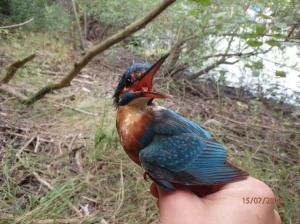Conclusions

All in all, there seem to be several main factors that influence the kingfisher population in southern Sweden. While winter severity had a huge impact on the already existing population, it did not affect the breeding success of the parents. Quick recoveries in warmer years that followed a cold year were therefore possible, which lead to strong fluctuations of the population. While the size of the population did not seem to affect the breeding success, it varied between sites. Higher frequented sites were concluded to be of higher quality and showed higher success rates. Habitat colonization by the kingfisher was influenced by the quality of the area, as well as by the number of birds nesting simultaneously. Avoiding competition in low density years seemed to be favored over breeding in the best habitat, while better areas would be the ones to be shared first when populations increased. Individual nesting site quality thereby played a minor role, whereas the surrounding area seemed to be of higher importance. The availability of high quality breeding areas and not the number of breeding sites therefore might be a possible limiting factor for the kingfisher population in this region.
Responsible for this page:
Director of undergraduate studies Biology
Last updated:
05/09/17
